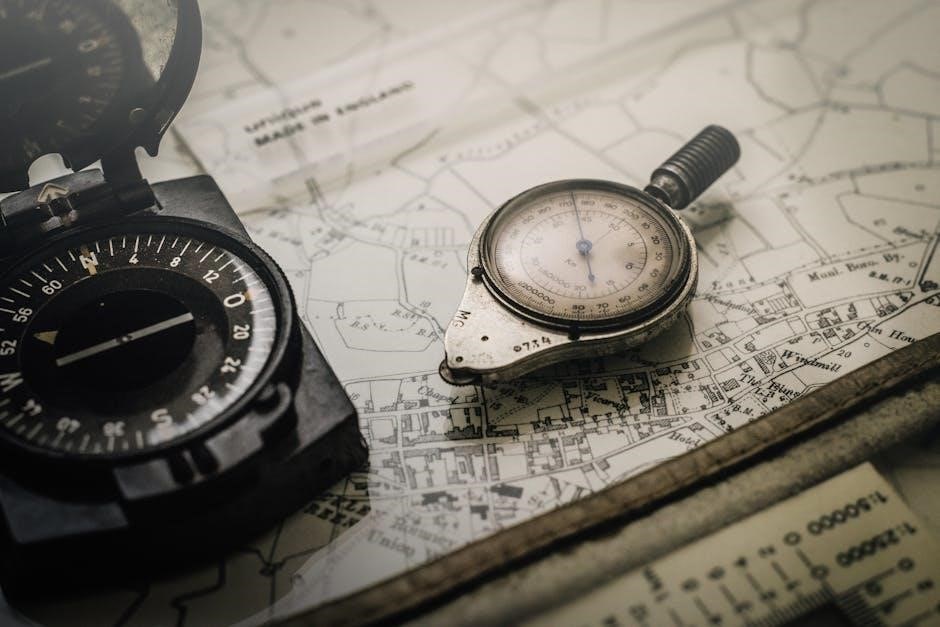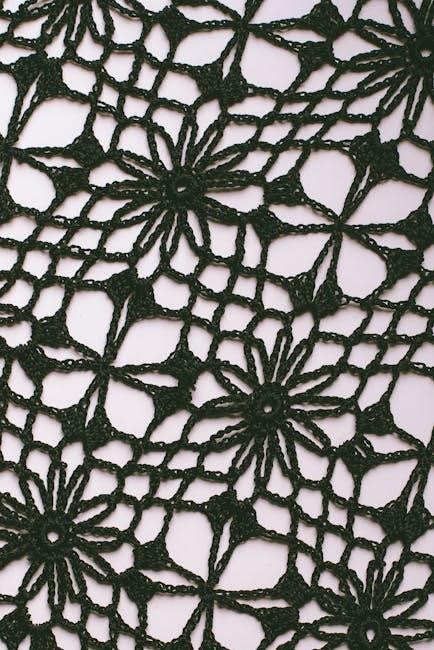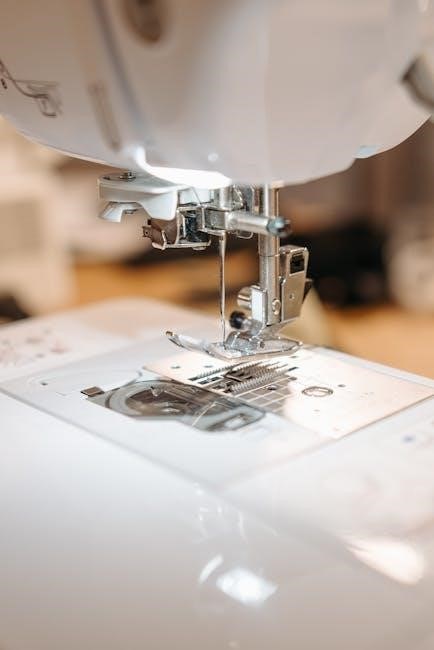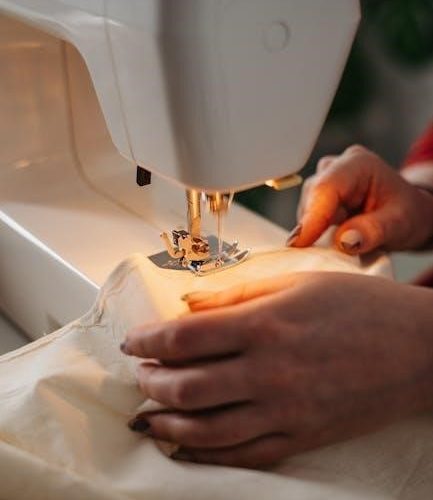The UNF Thread Chart PDF provides detailed specifications for Unified National Fine threads, including dimensions, tolerances, and designations․ Based on the ASME B1․1 standard, it offers a comprehensive guide for engineers and manufacturers to ensure accuracy and consistency in thread applications․ The chart includes nominal diameter, pitch, and threads per inch (TPI), making it an essential resource for precise screw thread design and implementation․
Overview of UNF Threads
Unified National Fine (UNF) threads are a type of screw thread standard designed for applications requiring finer pitches compared to the coarser UNC series․ They are defined by the ASME B1․1 standard, which specifies dimensions, tolerances, and designations for UNF threads․ These threads are characterized by their fine pitch, which provides a stronger mating and better resistance to vibration․ UNF threads are commonly used in precision engineering, aerospace, and automotive industries where high performance and reliability are critical․ The thread dimensions are expressed in inches, with sizes ranging from 0 to 1, and pitches varying to suit specific applications․ The UNF thread chart PDF serves as a reference guide, detailing major and minor diameters, pitch diameters, and threads per inch (TPI), ensuring accurate implementation in manufacturing and design processes․
Importance of UNF Thread Chart PDF
The UNF Thread Chart PDF is an indispensable resource for engineers, manufacturers, and technicians working with Unified National Fine threads․ It provides standardized specifications and dimensions, ensuring compliance with the ASME B1․1 standard․ This chart is crucial for maintaining consistency and accuracy in thread design, particularly in industries like aerospace and automotive, where precision is paramount․ By referencing the chart, professionals can quickly determine thread dimensions, such as nominal diameter, pitch, and threads per inch (TPI), as well as tolerances and allowances․ This ensures that components fit together seamlessly, reducing the risk of assembly issues and improving product reliability․ Additionally, the chart simplifies the selection of appropriate tools and materials, streamlining the manufacturing process․ Its portability and ease of use make it a vital tool for both design and quality control, fostering efficiency and adherence to industry standards․

Structure and Content of the Chart
The UNF Thread Chart PDF is organized into a clear, tabular format, making it easy to navigate and reference․ It includes detailed specifications for Unified National Fine threads, such as nominal diameter, pitch, and threads per inch (TPI)․ The chart lists the major diameter, minor diameter, and pitch diameter, along with their respective minimum and maximum tolerances․ Additional information includes thread series, classes, and designations, providing a comprehensive overview of each thread size․ The chart also specifies recommended drill sizes for tapping applications and includes allowances for thread fit and finish․ Visual aids, such as diagrams and formulas, are often incorporated to clarify complex dimensions and relationships․ This structured approach ensures that users can quickly find the information they need, making it an essential tool for design, manufacturing, and quality control processes․ The chart’s clarity and precision make it a reliable reference for professionals working with UNF threads․

UNF Thread Specifications
The UNF Thread Specifications are defined by the ASME B1․1 standard, covering Unified National Fine (UNF) and Unified National Round (UNR) threads․ These specifications ensure precise manufacturing and design consistency․
ASME B1․1 Standard for UNF Threads
The ASME B1․1 standard governs the specifications for Unified Inch Screw Threads, including UN (coarse) and UNF (fine) thread forms․ It provides detailed requirements for thread dimensions, tolerances, and designations, ensuring consistency in manufacturing and design․ The standard applies to all screw threads used in mechanical fasteners, covering both external and internal threads․ Key aspects include thread form, major and minor diameters, pitch, and thread angles; The standard also addresses allowances and limits for fit classes, critical for proper mating of threads․ Engineers and manufacturers rely on ASME B1․1 for precise thread specifications, enabling interchangeability and reliability in assembled products․ Supplementary materials, such as thread calculators and charts, complement the standard, aiding in practical applications․ This standard is widely adopted across industries, including aerospace, automotive, and industrial manufacturing, ensuring uniformity and quality in screw thread production․
Thread Designation and Classification
Thread designation for UNF threads follows a specific format, typically expressed as nominal diameter-pitch-threads per inch-series․ For example, a designation like 1/2-13UNF-2A indicates a nominal diameter of 1/2 inch, 13 threads per inch, and a Class 2A fit for an external thread․ Similarly, 1/2-13UNF-2B denotes a Class 2B internal thread․ This standardized system ensures clarity and consistency in specifying thread requirements․ Classification of threads into classes of fit (1, 2, or 3) defines the tolerance ranges for pitch diameter and major/minor diameters, ensuring proper mating of threads․ Class 2 is the most common, offering a medium tolerance for general applications․ This structured designation and classification system is crucial for precise communication in engineering and manufacturing, enabling the correct selection and production of UNF threads․ It aligns with the ASME B1․1 standard, ensuring interchangeability and reliability in assembled components․
Series and Classes of UNF Threads
UNF threads are part of the Unified National series, which includes UNC (coarse) and UNF (fine) threads․ The UNF series is designated for applications requiring finer pitches and tighter tolerances compared to UNC threads․ Classes of fit for UNF threads are categorized into Class 1, Class 2, and Class 3, with Class 2 being the most commonly used․ Class 1 provides the loosest tolerances, suitable for general applications where interchangeability is less critical․ Class 2 offers medium tolerances, balancing precision and cost, making it ideal for most engineering applications․ Class 3 provides the tightest tolerances, ensuring maximum precision and interchangeability, typically used in high-precision machinery․ The classification system ensures that threads can be tailored to specific requirements, whether for standard or specialized uses․ This structured approach to thread classification enhances compatibility and performance in assembled components, aligning with the ASME B1․1 standard for unified screw threads․
Thread Dimensions and Parameters
The UNF thread chart outlines key dimensions, including nominal diameter, pitch, major diameter, minor diameter, and pitch diameter․ These parameters ensure precise engineering and manufacturing applications, adhering to ASME B1․1 standards․
Nominal Diameter and Pitch
Nominal Diameter and Pitch
The nominal diameter in UNF threads refers to the major diameter of the screw thread, measured in inches․ It is a critical parameter for identifying thread size and compatibility․ The pitch, defined as the distance between corresponding points on adjacent threads, is another essential dimension․ Together, these measurements determine the thread’s overall size and spacing․ For example, a 1/2-20 UNF thread has a nominal diameter of 0․5 inches and a pitch of 1/20 inch․ The chart provides detailed tables correlating nominal diameters with their respective pitches, ensuring accurate selection and application․ This information is vital for engineers and manufacturers to maintain consistency and meet ASME B1․1 standards in their designs and production processes․
Pitch Diameter and Tolerance Ranges
The pitch diameter is a critical measurement in UNF threads, representing the average of the major and minor diameters․ It is essential for ensuring proper thread fitment and functionality․ The tolerance ranges for pitch diameter are specified in the UNF thread chart to accommodate manufacturing variations while maintaining precision․ These tolerances are divided into minimum and maximum limits, ensuring compatibility between mating threads․ For instance, a 1/2-20 UNF thread has a pitch diameter tolerance range that guarantees proper assembly and load-bearing capacity․ The chart provides detailed tables outlining these ranges for various thread sizes, allowing engineers to select appropriate dimensions for their applications․ Adhering to these specifications ensures compliance with the ASME B1․1 standard and maintains the integrity of threaded connections in mechanical systems․

Threads per Inch (TPI) and Series
The UNF thread chart details Threads per Inch (TPI) and series, with TPI ranging from 20 to 80 for fine threads․ It differentiates UNF (fine) and UNC (coarse) series, aiding engineers in selecting appropriate thread specifications for various applications․
Understanding TPI in UNF Threads

Threads per Inch (TPI) in UNF threads refers to the number of threads completed within a one-inch length of the screw․ TPI is a critical parameter for determining thread spacing and pitch․ For UNF threads, TPI typically ranges from 20 to 80, with higher TPI indicating finer threads․ A higher TPI results in a smaller pitch, which is the distance between corresponding points on adjacent threads․ Understanding TPI is essential for selecting the appropriate thread size for specific applications, as it directly affects the thread’s strength, fit, and compatibility․ Engineers use the UNF thread chart to identify the correct TPI for their designs, ensuring precise alignment and functionality․ Proper TPI selection also influences the manufacturing process, particularly in tapping and threading operations․
UNF vs․ UNC Thread Series
The UNF (Unified National Fine) and UNC (Unified National Coarse) thread series are two primary classifications under the Unified Inch Screw Thread system․ The key difference lies in their thread pitch and applications․ UNF threads have a finer pitch, meaning more threads per inch (TPI), which results in a smaller diameter and tighter fit․ This makes them ideal for applications requiring high precision, such as aerospace and defense․ In contrast, UNC threads have a coarser pitch, fewer TPI, and a larger diameter, making them suitable for general engineering and construction where strength and ease of assembly are prioritized․ While both series are standardized under ASME B1․1, their designations differ in thread spacing and usage․ Engineers often refer to the UNF thread chart to distinguish between these series and select the appropriate one for their specific needs․
Recommended Drill Sizes for UNF Threads
When working with UNF threads, selecting the correct drill size is crucial for achieving precise thread fit and functionality․ The UNF thread chart PDF provides detailed recommendations for drill sizes corresponding to each thread specification․ For example, a 0-80 UNF thread typically requires a #53 drill bit, while larger threads may need proportionally bigger drills․ These recommendations ensure that the tapped hole aligns with the thread’s minor diameter, allowing for proper engagement․ The chart also accounts for thread pitch and series, offering specific guidance to maintain dimensional accuracy․ By following these guidelines, manufacturers can avoid common issues like oversized or undersized holes, which can lead to thread damage or assembly problems․ The ASME B1․1 standard further supports these recommendations, ensuring consistency across engineering and manufacturing applications․ Using the correct drill size is essential for achieving the desired thread quality and performance․

Applications of UNF Threads
UNF threads are widely used in aerospace, defense, and automotive industries due to their fine pitch and high precision․ They are ideal for applications requiring tight tolerances and compact designs, ensuring reliable fastening solutions․
Use in Aerospace and Defense
UNF threads are extensively used in aerospace and defense industries due to their high precision and reliability․ These industries require strict adherence to standards like ASME B1․1 to ensure safety and performance․ The fine pitch of UNF threads makes them ideal for applications where space and weight are critical, such as in aircraft components, missile systems, and satellite hardware․ Their ability to withstand vibration and stress in harsh environments further enhances their suitability for military and aerospace applications․ Engineers rely on the UNF thread chart PDF to specify nominal diameter, pitch, and tolerance ranges, ensuring compatibility and consistency in critical systems․ This standardization is vital for maintaining the integrity of high-strength, lightweight fasteners used in advanced engineering projects․ The chart’s detailed specifications help prevent errors, making it an indispensable tool in these demanding fields․
Automotive and Industrial Applications
UNF threads are widely utilized in automotive and industrial applications due to their precision and reliability․ In the automotive sector, they are used in engine components, gearboxes, and other high-performance systems where tight tolerances are essential․ The fine pitch of UNF threads ensures minimal vibration and stress, making them ideal for applications involving frequent movement or heavy loads․ In industrial settings, these threads are commonly found in machinery, pumps, and hydraulic systems, where durability and consistency are critical․ The UNF thread chart PDF serves as a vital reference for engineers, providing detailed specifications for thread dimensions, pitch, and tolerance ranges․ This ensures compatibility and accuracy in manufacturing processes․ With a wide range of sizes and pitches available, UNF threads are adaptable to various industrial needs, making them a cornerstone of modern engineering and production․ Their standardized design simplifies component interchangeability, reducing production costs and enhancing efficiency․
Other Engineering and Manufacturing Uses
Beyond automotive and aerospace, UNF threads are integral to various engineering and manufacturing applications․ They are commonly used in high-precision devices, medical equipment, and consumer goods, where their fine pitch and tight tolerances ensure reliability․ The UNF thread chart PDF is a crucial resource for these industries, providing detailed specifications for thread dimensions, pitch, and tolerance ranges․ In robotics and automation, UNF threads are used for assembling components that require minimal vibration and high torque․ Additionally, they are employed in optical instruments, where precise alignment and stability are essential․ Their versatility extends to microelectronics and precision machinery, ensuring compatibility and consistency across diverse manufacturing processes․ The standardized nature of UNF threads simplifies design and production, making them a preferred choice for engineers worldwide․ By referencing the UNF thread chart PDF, manufacturers can ensure accuracy and efficiency in their operations․

How to Read the UNF Thread Chart
Understanding the UNF Thread Chart involves interpreting dimensions, tolerances, and thread designations․ It provides precise data on nominal diameter, pitch, and threads per inch, ensuring accurate fastener specifications and compliance with the ASME B1․1 standard․

Interpreting Dimensions and Tolerances

Interpreting dimensions and tolerances in the UNF Thread Chart is crucial for accurate fastener specifications․ The chart provides detailed measurements, including nominal diameter, major diameter, pitch diameter, and threads per inch (TPI)․ Tolerances are specified as minimum and maximum values for each dimension, ensuring precision in manufacturing․ For example, the pitch diameter tolerance ranges are provided to maintain consistency across threaded components․ Understanding these values helps in selecting the correct drill sizes and ensuring proper thread fitment․ The chart also includes allowances and tolerances for both external and internal threads, adhering to the ASME B1․1 standard․ By referencing these specifications, engineers can design and manufacture components that meet strict quality and performance requirements․ Accurate interpretation of these dimensions and tolerances is essential for ensuring compatibility and reliability in threaded assemblies․
Understanding Thread Designation Examples
Understanding thread designation examples is essential for correctly interpreting the UNF Thread Chart․ A typical designation for a UNF thread might be written as 1/2-20 UNF, where 1/2 represents the nominal diameter, and 20 indicates the number of threads per inch (TPI)․ The UNF suffix denotes the thread series․ Another example, 0-80 UNF, specifies a smaller thread with a nominal diameter of 0 and 80 TPI․ These designations are standardized according to the ASME B1․1 standard, ensuring consistency across manufacturing and engineering applications․ By analyzing these examples, users can accurately identify thread specifications, such as major and minor diameters, pitch, and tolerance ranges․ This understanding is critical for selecting the correct fasteners and ensuring proper fitment in assembled components․ The chart provides clear examples to guide users in interpreting and applying thread designations effectively․
Practical Tips for Using the Chart
When using the UNF Thread Chart PDF, start by referencing the ASME B1․1 standard to ensure compliance with specifications․ Always verify the thread designation format, such as 1/2-20 UNF, to identify nominal diameter and threads per inch (TPI)․ Pay attention to the chart’s structure, focusing on columns for major diameter, pitch diameter, and tolerance ranges․ For precise applications, use the provided drill size recommendations to maintain thread accuracy․ Cross-reference the chart with thread calculators or additional resources for complex calculations․ Print the chart for quick offline access, especially in manufacturing or fieldwork settings․ Highlight or bookmark frequently used thread sizes for faster lookup․ Regularly update your chart to ensure you have the latest specifications and standards․ By following these tips, users can maximize the chart’s utility and ensure accurate thread specifications in their projects․
Downloading and Using the UNF Thread Chart PDF

Download the UNF Thread Chart PDF from trusted sources, ensuring compliance with the ASME B1․1 standard․ Print the chart for easy reference and use it to verify thread specifications in engineering projects․
Steps to Download the Chart
To download the UNF Thread Chart PDF, visit trusted engineering or standards websites that provide resources compliant with the ASME B1․1 standard․ Ensure the source is reliable to maintain accuracy․ Search for “UNF Thread Chart PDF” and select a verified link․ Once on the page, look for a download button or option to save the PDF directly․ Some sites may require registration or verification to access the chart․ After downloading, open the PDF to verify its content, ensuring it includes detailed thread specifications, dimensions, and tolerances․ For offline use, print the chart on high-quality paper for clear visibility․ Always cross-reference the chart with official standards to ensure compliance․ This guide is essential for engineers, manufacturers, and technicians working with Unified National Fine threads․
Printing and Referencing the Chart
Printing the UNF Thread Chart PDF ensures easy access and practical use in workshops or offices․ Use a high-resolution printer to maintain clarity, and select standard paper sizes like A4 or Letter for convenience․ Ensure the chart is printed in full color to distinguish between different thread specifications and dimensions․ For durability, consider laminating the chart or binding it into a booklet․ When referencing, use tabs or page markers to quickly locate specific thread sizes or parameters․ Cross-reference the chart with the ASME B1․1 standard to ensure compliance with industry specifications․ Regularly update the chart to reflect the latest standards and revisions․ This printed guide is invaluable for engineers, technicians, and manufacturers needing precise thread dimensions and tolerances for their projects․
Tools and Resources for Thread Calculation
Several tools and resources are available to assist with UNF thread calculations, ensuring accuracy and efficiency․ Thread calculators, both online and downloadable, provide instant calculations for dimensions like major diameter, pitch diameter, and minor diameter․ These tools often include options to input custom specifications or select from predefined standards․ Additionally, software like CAD programs and specialized engineering applications offer advanced thread design and analysis capabilities․ The ASME B1․1 standard serves as a primary reference for thread calculations, outlining formulas and tolerances․ For further guidance, textbooks such as “Machinery’s Handbook” by Oberg, Jones, Horton, and Ryffel offer detailed explanations and examples․ Online forums and engineering communities also provide support for complex calculations and troubleshooting․ These resources collectively enable precise and compliant thread design, making them indispensable for professionals working with UNF threads․
The UNF thread chart is a crucial resource for engineers, adhering to ASME B1․1 standards․ It provides essential thread specifications, supported by references like Machinery’s Handbook, ensuring precise manufacturing processes․
The UNF thread chart PDF is a vital resource for engineers and manufacturers, providing detailed specifications for Unified National Fine threads․ It adheres to the ASME B1․1 standard, ensuring accuracy in thread design and implementation․ The chart includes essential parameters such as nominal diameter, pitch, and threads per inch (TPI), along with tolerance ranges and recommended drill sizes․ It serves as a comprehensive guide for understanding and applying UNF threads in various industries, including aerospace, automotive, and industrial manufacturing․ By referencing this chart, professionals can ensure compliance with standardized thread dimensions and specifications, facilitating precise and reliable screw thread applications․ The chart is complemented by tools and resources, such as thread calculators, to aid in practical implementation․ Overall, the UNF thread chart PDF is an indispensable tool for ensuring quality and consistency in engineering and manufacturing processes;
Additional Resources and References
For further understanding of UNF threads, refer to the ASME B1․1-2003 standard, which provides detailed specifications for Unified Inch Screw Threads․ Supplementary resources include thread calculators and design guides available online․ The book “Unified Inch Screw Threads (UN and UNR Thread Form)” by Oberg, Jones, Horton, and Ryffel offers in-depth insights․ Additionally, the “Machinery’s Handbook” by the same authors is a valuable reference for thread design and calculation․ Online platforms provide comprehensive UNF thread charts and calculators, aiding in practical applications․ For precise manufacturing, consult the ASME B1․1 standard and related engineering handbooks․ These resources ensure accuracy and compliance with industry standards, making them essential for professionals working with UNF threads․
